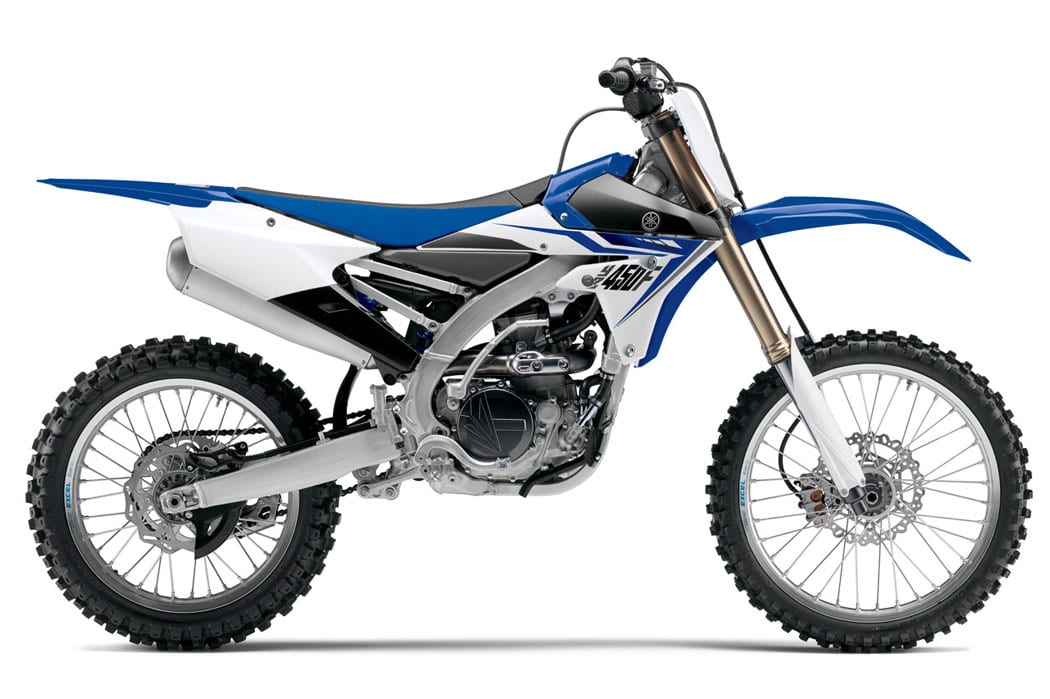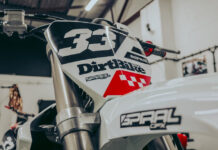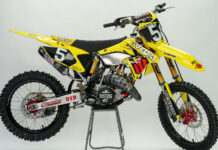With Yamaha pulling out all the stops to make their new YZ450F a winner we flew Ed Bradley out to Florence where he got to ride the machine…
It would seem that Yamaha have been pretty quiet for the past couple of seasons and it’s easy to forget how successful the brand has been over the years. When it comes to innovation Yamaha have always been right at the forefront of new development and in 1997 this Japanese manufacturer pulled out the shock of the century – catching all the others with their pants down – by revealing their factory 400cc four-stroke which kick-started a whole new generation of four-stroke motocross machines and ultimately changed the face of the sport. After a development period of 12 years – which included the introduction of Yamaha’s aluminium frame – in 2010 the R&D team pulled out yet another radical manoeuvre and produced the first backward engine ever seen in motocross. It follows a logical flow for gases with air in through the front and exhaust gases out the back. Although the 2010 YZ450F was technologically a great leap forward, in terms of performance it was not that much better at all.
The first generation for this new style of motor layout has now been superseded by the latest generation bike and Florence is where we got to test this new machine at a super circuit called Ponte a Egola which is a Grand Prix track from as far back as the mid ’80s. Falling out of favour with the world championship circus in recent years it’s resorted to hosting Italian championship races instead but is still a banging track. Under serene blue skies and in 30-degree plus heat we got to make the bike sing around this hardpack and hilly circuit and before we go in to that let’s discover what Yamaha have come up with…
The new YZ450F has had a whole host of modifications and updates, the main attention being on what all the manufactures seem to be focusing on at the moment and that is mass centralisation. The goal is to move as much weight low down and toward the centre of the bike as possible which is creating a new level of rider confidence in the ability to throw the bike around as if it’s a kids toy rather than a traditional style, big n’ heavy 450cc machine that has a whole lot of inertia limiting the rider in manoeuvrability – especially in the air!
They have achieved this by moving the electrics, wiring and fuel pump around which also improves the serviceability and access to the cylinder head. This may only seem like small components that weigh very little, however, by doing this they have been able to move the fuel tank lower inside the frame. The fuel tank is bigger as a result and holds over seven litres of petrol and because of its relocation Yamaha have been able to redesign the airbox, intake and filter but I’ll expand on that in a wee while.
The frame itself is smaller and has nearly the same dimensions of the 250F’s chassis which continues to add to the mass centralisation. The rigidity is improved and there is a new steering head tube that is 10mm closer towards the rider – this improves the feel of the bike for when you are sat this blue steed. Fitted to the new head tube is a newly designed triple clamp with rubber mounted bar clamps. One of the most obvious changes to the bilateral aluminium framed chassis is the sub-frame that looks peculiar to the eye. It is smaller in design and is lighter too but can still take the weight of my fat ass easily although it still seems strange that there’s no airbox in there – just plenty of room for the shock!
The shock has been changed back to a piggyback style reservoir now that the exhaust pipe has a new route which I’m sure also means that there is less heat to warm up the shock body and helps eliminate any fading. I wish the same could be said about me as I was melting in the high Italian heat after a couple of laps of riding.
At the front end of the bike the forks remain with a cartridge style system although the front axle has now been increased in diameter from 20 to 22mm for more rigidity to give better rider feedback and a more direct feel to the track surface.
In the motor department there have been small but significant changes that will add to Yamahas backward facing engine performance such as increased cylinder head intake port volume with larger intake valves that are opened off a new cam profile. The exhaust valves have also been increased to match the flow of the intake gases too.
Just below the valves is a modified piston which increases combustion of this locomotive and reduces friction to make it a slippery light blighter. To hang on to and deliver the better production of power this four-fiddy has new clutch plate material to put the power down on the ground. To give a lighter clutch feel Yamaha have given it a better clutch cable too – it’s the little things that count! A major change to the engine is the removal of the oil tank and the transition to a wet sump. This means that the crankcases have been redesigned which gives a reduction in weight – not only by using less material but from the oil quantity too as the engine now holds only 0.95 litres compared to 1.2 on the 2013 model.
To improve the power delivery for 2014 Yamaha have re-routed the exhaust pipe around the cylinder which has given extra length to get some much needed torque from the power delivery. So instead of heating the shock up, like on the 2013 model, the cylinder is now going to get an extra hug of loving warmth (this was no problem when we were riding although I did notice that my knees were warming up when we started doing some stopping and starting and waiting around with the bike idling). More importantly though the end of the silencer is a noticeable 18mm closer towards the bike, improving to the bike’s mass centralisation.
The gearbox has had some love too. The selector and drum has been modified, third gear is now shorter and more in line with the other gear ratios to make a smoother transition between shifting gears. We know this for certain because the graphics that we were shown in a presentation had been highlighted in a different colour!
One of the best things about this new generation machine is that the airbox has been completely redesigned and now only involves removing three bolts to make a filter change. If you are already a YZ450F owner you’ll know how awesome this is. The filter is more like a conventional motocross foam filter and the air duct above the radiator scoops is boxed and channelled straight into the filter area which should reduce the amount of dirt heading into the box. This design also reduces, almost eliminates, the odd hoover style sucking noise you get from the air filter being above and in front of the engine. These two things – easy access to change the filter and reduced noise – are massive benefits over the previous models.
However, if you have been on a 2010 to 2013 model bike then sitting on the 2014 machine will blow your mind because it no longer feels like you have a space hopper between your thighs. The Japs have chopped off a massive 8.8mm on each side of the off the bike by reducing the radiator width allowing them, in turn, to reduce the width of the air intake. The result being a bike that feels almost normal when compared to conventional forward facing engined machines.
Adding to this super slim feeling is the fact that there is no fuel cap on display. The fuel filler is tucked neatly under a seat-like padded cover with just the breather pipe sticking out. It’s hardly noticeable that there is no fuel cap but it just gives you a subconscious safety cushion knowing that there’s nothing there to whack your nuts on when riding! Our first session out on the hilly, tight and twisty circuit was with everything set to standard – suspension clickers, fork height and ECU map with only the preload set to our individual weight and of course the bars and levers set to our own liking. The track had its fair share of braking bumps, a few ruts and berms with some small kickers on the jump faces. It was ideal for discovering what this bike had to offer where it matters most – turning out the laps. The layout of the bike feels great with a comfortable footrest/seat/handlebar positioning that will suit both shorter and taller riders alike.
It feels light to ride too and right away you notice that this bike is really easy to turn in a quick, easy and precise way while the bike still maintains its stability on the longer straights. The more I rode the bike, the more my confidence grew – especially on the jumps. The movement towards mass centralisation is the reason for this growth in rider confidence. Straight away I wanted to scrub everything that had a take off and if there wasn’t one, I wanted to find one! I felt that I could lay the bike flatter and turn the bike more across the track as I went over the tabletops – more than I was doing and still land the bike in total control. It was more a matter of daring myself to do it rather than being scared of the consequences of going too far!
As the track had been watered in the morning by the time I got out there, there was plenty of grip even though the ground was drying up fast so the power delivery went down really well with good feedback on the motor’s response from the right hand movements!
The low-end power is really playful – responsive and strong which is great in the tight turns and for building up speed on the exit of turns although I did struggle to find a happy ground between second gear which ran out too quickly and third gear which was just a little too tall for the tight corners. This is mostly because as the power moves away from the low to mid-range it is hit by an almighty surge of power that feels like someone has a massive hand on your back pushing you forward. It’s incredible and on a track with grip as we had here and circuits that are sand and loamy then this map setting will be right up your street.
The next time out on the track I tested a softer map curve that would knock out the torque pull and an even softer mapping curve than this one. The track had dried out so the aim was to find a power delivery that would be smooth enough to get great drive out of the turns. What I found out was that the softest map just meant that I was thrashing the nuts off the bike all over the place and I didn’t feel like I was getting anywhere fast and that the bike became noisier around the front of the bike where the air filter is as air was being rapidly sucked in. The setting in between was just right though – it was Goldilocks bed and perfect for her! Smooth enough to be able to put the power down hard out of the turns and strong enough to keep the bike pulling and driving on the top-end for the longer straights.
This bike definitely has a new attitude and on a technical, demanding track in heat of over 30 degrees all I wanted to do was get back out on the track so I could ride this bike again and it continued to inspire me each time I went out on it.
It would also seem that this new attitude has found its way into Yamaha UK’s heart too as there will be plenty of the 2014 model bikes to go around and they are massively cheaper than previous offerings too. With the 250F sharing many parts with its big brother production costs are down and the retail value of this new generation machine is nearly a grand cheaper than last year at £6599. I’m sure that’s music to your ears…
Specification:
YZ 450F specifications









